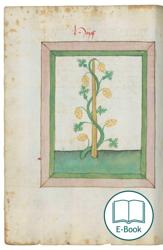Before the middle of the fifteenth century the Munich physician and author wrote an herbal that describes the medical efficacy of more than 170 drugs drawn from plants and animals. With its large format pictorial representations of animals and plants, it is the only completely illustrated herbal from the incunable period in the German language. The text is presented here for the first time in a critical edition. Information about the author, the transmission and textual history, as well as a glossary complement the edition. Furthermore, a representative selection of 64 full-page color reproductions is appended from the lead manuscript used as the basis for the text.
The herbal of the Munich physician and writer Johannes Hartlieb († 1468) occupies a special place in the medical literature of the Middle Ages, for it is the only comprehensively illustrated herbal from the incunable period in the German language. Hartlieb, who was educated in Padua and was personal physician to the Bavarian dukes Albrecht III and Siegmund, put his herbal together before the middle of the century. What is special and innovative about this work, which encompasses more than 170 chapters, are the illustrations of the drugs. They are present in all the extant manuscripts and form an integral part of the work.
The structural framework for the sequence of chapters in the herbal is formed by the alphabetically arranged section about herbs from the “Buch der Natur” by the Regensburg cathedral canon Konrad of Megenberg († 1374), whose text Hartlieb took over word-for-word almost in its entirety. In addition, he enriched his work with 76 additional chapters on drugs, arranged as a rule alphabetically in a block at the end of each letter of the alphabet. Sources have been found for only a small number of these additional chapters. Nonetheless, it must remain an open question as to whether the remaining chapters are an original contribution by Hartlieb to this herbal; it is more probable that they are derived from a source that has not yet been identified. Hartlieb departed from the alphabetical principle of arrangement in his opening chapters, which have drugs derived from animals as their content. Here Konrad also turned to the encyclopedia of nature by Konrad of Megenberg, but in this case he excerpted only the medically relevant portions of the corresponding chapters on four-footed animals.
The first critical edition of this text on the basis of the entire tradition known to us today fulfills a long-recognized gap in the literature. Until now there have only been reprints of a fragmentarily transmitted manuscript from the Upper Austrian State Museum at Linz and a text witness from the Princely Salm-Salm’sche Library in Anholt that was only very recently found. Information about the author, the transmission and textual history, as well as a glossary complement the edition. The significance of the illustrations for this innovative herbal type was taken into account to the extent that a representative selection of 64 full-page color reproductions of animal and vegetable drugs could be added. They are derived from the lead manuscript from which the text is drawn. The illustrations make it clear that the animals and plants are not drawn from nature but rather in keeping with the iconographic tradition.
„Hartliebs „Kräuterbuch“ gehört zu den am besten erschlossenen Texten seiner Art. Nach der Erstedition einer unvollständigen (Linzer) Hs. 1958, die 1980 durch ein Teilfaksimile und 1989 durch eine Teiledition ergänzt wurde, erschien 2004 das Faksimile einer weiteren, wenn auch ihrerseits fehlerhaften hs. (Anholt-Moylönder Kräuterbuch), die jedoch sorgfältig transkribiert, übersetzt und ausführlich erläutert wurde. Nun liegt eine kritische Ausgabe vor, die zwar einer Leithandschrift (Berlin, Ms. Germ. Qu. 2021) folgt, jedoch - dem Sachtextcharakter entsprechend - auf inhaltliche Korrektheit Wert legt und erkennbare Irrtümer zu verbessern sucht. Da eine enge Text-Bild-Beziehung das wesentliche Charakteristikum dieses Kräuterbuches ist, wurden 64 ganzseitige Farbabb. aus der Berliner Hs. angefügt. Die knapp gehaltene Einl. stellt den Autor vor, referiert den Forschungsstand, schildert Aufbau, Vorlagen (besonders Konrad von Megenberg) und Bearbeitungsweise, beschreibt die erhaltenen Hss., rekonstruiert die Textgeschichte und erklärt die Editionsprinzipien. Eine gewisse Normalisierung der Schreibweisen, ein Glossar und besonders der übersichtliche Anmerkungsapparat erleichtern die Benutzung für Nicht-Fachleute.“
Ortrun Riha
In: Germanistik. 52 (2001) 1-2. s. 216-217.
Gerold Hayer
geboren 1945, Studium der Germanistik, Geschichte und Philosophie an der Universität Salzburg, 1972 Dr. phil., 1973 wiss. Mitarbeiter an Forschungsprojekten, 1981 Universitäts-Assistent, seit 1992 Univ.-Doz. für Ältere deutsche Sprache und Literatur und ao. Univ.-Prof. am Institut/Fachbereich für Germanistik an der Universität Salzburg.
Forschungsschwerpunkte: Spätmittelalterliche pragmatische Literatur, Text- und Überlieferungsgeschichte, Bibliotheksgeschichte.
Bernhard Schnell
geboren 1942, Studium der Germanistik und Geschichte an der Universität München, 1974-1990 wiss. Mitarbeiter (Forschergruppe „Prosa des deutschen Mittelalters“, Sonderforschungsbereich „Wissensorganisierende und wissensvermittelnde Literatur im Mittelalter“) in Würzburg, 1980 Dr. phil., 1990 Priv.-Doz. für Geschichte der Medizin, 1990-1994 akad. Oberrat am Institut für Geschichte der Medizin an der Univ. Würzburg, 1995-2007 Leiter der Arbeitsstelle des Mittelhochdeutschen Wörterbuchs an der Göttinger Akademie der Wissenschaften.
Forschungsschwerpunkte: Mittelhochdeutsche Lexikographie, deutsche Medizinliteratur des Mittelalters, Text- und Überlieferungsgeschichte.


 Preface
Preface